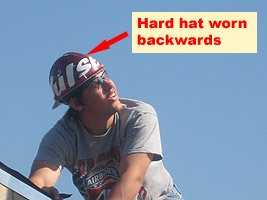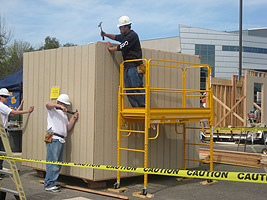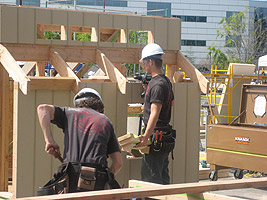
Supervision and Inspection
Most injuries occur during the first few months on a new job when individual are inexperienced. More young workers suffer serious injury and death than experienced workers. Students and young workers are more vulnerable than older, more experienced workers because they:
 Have the mindset they're invincible
Have the mindset they're invincible- Want to impress and please
- Feel the pressure of getting the job done and increase the pace of their work
- Do as they're told without questioning
- Are inexperienced
- Are easily distracted
- May be afraid to raise safety concerns
- Do not know or recognize the hazards in a work environment
As trainers of your students and young workers, you are responsible for educating them on workplace health and safety including (but not limited to): safe work practices, worker's rights, the importance of learning in safety meetings and other trainings, and complying with rules and regulations. To reduce the risk of injury and increase productivity, see the information below:
When training your students and young workers make sure and review with them their information on Supervision and Inspection.
Cal/OSHA has a number of regulations to help prevent injuries when working in
construction - found in Title 8 of the California Code of Regulations (T8CCR). The complete set of Title 8 regulations can be found at:
www.dir.ca.gov/samples/search/query.htm
The Cal/OSHA regulations related to safety in construction can be found in:
- Chapter 4. Division of Industrial Safety, Sub-Chapter 4. Construction Safety Orders (Sections 1500 - 1938).
- T8CCR 1502 Application states, in part:
- These Orders establish minimum safety standards whenever employment exists in connection with the construction, alteration, painting, repairing, construction maintenance, renovation, removal, or wrecking of any fixed structure or its parts.
- At construction projects, these Orders take precedence over any other general orders that are inconsistent with them, except for Tunnel Safety Orders or Compressed Air Safety Orders.
The following is a brief summary of the regulations in Title 8 related to supervision and inspection on construction sites. Not all of the applicable Title 8 regulations addressing supervision of employees are given below.
- The Suggested Safety Program for Contractors General (Example in PLATE A-2) states in part that capable, responsible supervisors / foreman should:
 "make regular inspections of all excavations, forms, scaffolds, stairs, ladders, structures, machinery, and equipment at frequent intervals" and
"make regular inspections of all excavations, forms, scaffolds, stairs, ladders, structures, machinery, and equipment at frequent intervals" and- take immediate corrective action to eliminate hazards and to report violations of safety orders and safety work practices to the responsible employer -
- give individual safety instruction and orders as needed to new workers and those found to be working unsafely
- arrange for frequent and regular field safety inspections
- T8CCR, PLATE A-2-b, (c)(2) requires that adequate training and supervision be provided.
- T8CCR 1511 states in part that, prior to the presence of its employees, the employer shall make a thorough survey over the conditions of the site to determine, so far as practicable, the predictable hazards to employees and the kind and extent of safeguards necessary to prosecute the work in a safe manner in accordance with the relevant parts of plate A-2-a and b of T8 CCR 1938
Effective Supervision and Inspection should include:
- Establishing a good relationship
- Maintaining open lines of communication
- Listening
- Encouraging questions and getting feedback
- Elements such as:
- Ensuring safe work practices and controls are followed including:
 Pairing students and young workers with older and more experienced workers who can act as mentors and reinforce safe work practices.
Pairing students and young workers with older and more experienced workers who can act as mentors and reinforce safe work practices.- Identifying specific, riskier tasks that require constant supervision and allocating supervisors to monitor them
- Assessing competency for doing tasks safely
- Inspecting the workplace regularly and correcting unsafe acts or conditions in a timely manner
- Stressing safety daily and the importance of reporting unsafe conditions immediately
- Leading by example and demonstrating a personal commitment to safety in the worksite every day
- Recognizing responsible students and young workers for their good safety record
- Making sure that PPE of the right size is provided, worn properly, inspected, and maintained
- Disciplining when necessary
- Ensuring safe work practices and controls are followed including:
February 2010

